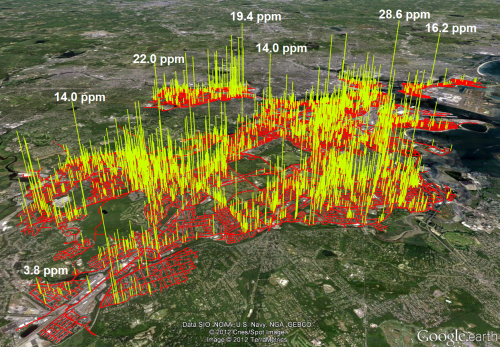Study details natural gas leaks in Boston

(Phys.org)—The City of Boston is riddled with more than 3,000 leaks from its aging natural-gas pipeline system, according to a new study by researchers at Boston University and Duke University. Their findings appear this week in the online edition of the peer-reviewed journal Environmental Pollution.
The new study comes in the wake of devastating fires fueled by natural gas during Hurricane Sandy. Potential damage to gas pipeline pressure regulators, caused by flooding in Hurricane Sandy, has raised ongoing safety concerns in New York and New Jersey.
The researchers report finding 3,356 separate natural gas leaks under the streets of Boston. "While our study was not intended to assess explosion risks, we came across six locations in Boston where gas concentrations exceeded the threshold above which explosions can occur," said Nathan Phillips, associate professor in BU's Department of Earth and Environment and co-author of the study.
Nationally, natural gas pipeline failures cause an average of 17 fatalities, 68 injuries, and $133M in property damage annually, according to the U.S. Pipeline and Hazardous Materials Safety Administration. In addition to the explosion hazard, natural gas also poses a major environmental threat: Methane, the primary ingredient of natural gas, is a powerful greenhouse gas that degrades air quality. Leaks in the United States contribute to $3 billion of lost and unaccounted for natural gas each year.
"Repairing these leaks will improve air quality, increase consumer health and safety, and save money," said co-author Robert B. Jackson, Nicholas Professor of Global Environmental Change at Duke. "We just have to put the right financial incentives into place."
Phillips and Jackson's teams collaborated with industry partners Robert Ackley of Gas Safety, Inc., and Eric Crosson of Picarro, Inc., on the study. They mapped the gas leaks under Boston using a new, high-precision methane analyzer installed in a GPS-equipped car. Driving all 785 road miles within city limits, the researchers discovered 3,356 leaks.
The leaks were distributed evenly across neighborhoods and were associated with old cast-iron underground pipes, rather than neighborhood socioeconomic indicators. Levels of methane in the surface air on Boston's streets exceeded fifteen times the normal atmospheric background value.
Like Boston, other cities with aging pipeline infrastructure may be prone to leaks. The researchers recommend coordinated gas-leaks mapping campaigns in cities where the infrastructure is deemed to be at risk. The researchers will continue to quantify the health, safety, environmental, and economic impacts of the leaks, which will be made available to policymakers and utilities as they work to replace and repair leaking natural gas pipeline infrastructure.
More information: Phillips, N.G., et al., Mapping urban pipeline leaks: Methane leaks across Boston, Environmental Pollutiondx.doi.org/10.1016/j.envpol.2012.11.003
Provided by Boston University Arts & Sciences

















